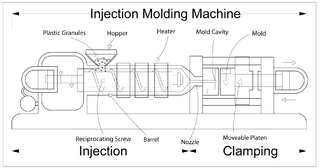
Snowboards are boards where both feet are secured to the same board, which are wider than skis, with the ability to glide on snow. Snowboards widths are between 6 and 12 inches or 15 to 30 centimeters. Snowboards are differentiated from monoskis by the stance of the user. In monoskiing, the user stands with feet inline with direction of travel, whereas in snowboarding, users stand with feet transverse to the longitude of the board. Users of such equipment may be referred to as snowboarders. Commercial snowboards generally require extra equipment such as bindings and special boots which help secure both feet of a snowboarder, who generally rides in an upright position. These types of boards are commonly used by people at ski hills or resorts for leisure, entertainment, and competitive purposes in the activity called snowboarding.

Alpine skiing, or downhill skiing, is the pastime of sliding down snow-covered slopes on skis with fixed-heel bindings, unlike other types of skiing, which use skis with free-heel bindings. Whether for recreation or sport, it is typically practised at ski resorts, which provide such services as ski lifts, artificial snow making, snow grooming, restaurants, and ski patrol.

Ice skates are metal blades attached underfoot and used to propel the bearer across a sheet of ice while ice skating.

Skiing, or traveling over snow on skis, has a history of at least eight millennia. The earliest archaeological examples of skis were found in Russia and date to 6000 BCE. Although modern skiing has evolved from beginnings in Scandinavia, 5000-year-old wall paintings suggest use of skis in the Xinjiang region of what is now China. Originally purely utilitarian, starting in the mid-1800s skiing became a popular recreational activity and sport, becoming practiced in snow-covered regions worldwide, and providing a market for the development of ski resorts and their related communities.
The parallel turn in alpine skiing is a method for turning which rolls the ski onto one edge, allowing it to bend into an arc. Thus bent, the ski follows the turn without sliding. It contrasts with earlier techniques such as the stem Christie, which slides the ski outward from the body ("stemming") to generate sideways force. Parallel turns generate much less friction and are more efficient both in maintaining speed and minimizing skier effort.
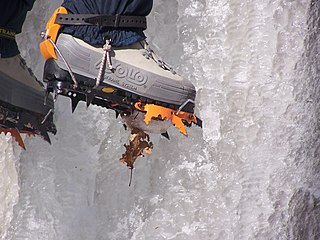
A crampon is a traction device that is attached to footwear to improve mobility on snow and ice during ice climbing. Besides ice climbing, crampons are also used for secure travel on snow and ice, such as crossing glaciers, snowfields and icefields, ascending snow slopes, and scaling ice-covered rock. There are three main attachment systems for footwear: step-in, hybrid, and strap bindings. The first two require boots with welts, as a tension lever attaches the crampon to the heel. The last type are more versatile and can adapt to virtually any boot or shoe, but often do not fit as precisely as the other two types.
The system was developed by Hannes Schneider while working as an instructor in the Arlberg mountains in Austria. His methods were popularized in Europe in a series of films in the 1920s and 30s. It became popular in the United States after Schneider moved there in 1939, having been jailed during the Anschluss.
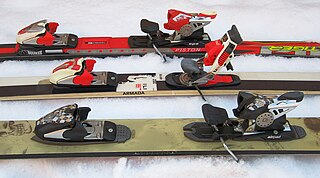
Marker has been a manufacturer of alpine ski bindings since 1952. Founded in Germany by Hannes Marker, the company is known for pioneering releasable binding technology. Marker's first model, the Duplex was followed in 1953 by the Simplex toe binding which was a huge success in the 1950s. New models introduced in the 1980s were major competitors on the alpine racing circuit. Marker remained independent until the 1980s, since then the company ownership switched hands several times until becoming part of the K2 Sports group, which in turn was purchased by Jarden in 2007.
Shin-bang is a general sense of discomfort/pain in the lower anterior portion of the tibia that contacts with the tongue of the ski boot, especially when pressed against the boot. Shin-bang is not to be confused with shin-bite, a condition where your shin is rubbed raw due to irritation inside of the ski boot.

Spademan was a type of ski binding, one of a number of "plate bindings" that were popular in alpine skiing during the 1970s. It used a bronze plate screwed into the bottom of the boot as its connection point, held to the ski by a clamp-like mechanism that grasped the side of the plate. Unlike conventional bindings, the Spademan could release in any direction, in response to any force or torque. It provided greatly improved protection compared to contemporary designs, which generally allowed release of the toe to the sides and heel directly forward, keeping the foot attached in any other fall direction.
The Head Standard was Howard Head's first successful ski design, and arguably the first modern downhill ski. The Standard used composite construction, with a plywood core sandwiched between aluminum outer skins, steel edges tapering into the core, and a hard plastic base, sidewalls and topsheet. The only major changes in ski materials since the Standard are the use of fibreglass structural layers in place of the aluminum layers, and substitution of expanded plastic foam for the wooden core.

Look's Nevada, released in 1950, was the first recognizably modern alpine ski binding. The Nevada was only the toe portion of the binding, and was used with a conventional cable binding for the heel. An updated version was introduced in 1962 with a new step-in heel binding, the Grand Prix. These basic mechanisms formed the basis for LOOK bindings for over 40 years, changing mainly in name and construction materials. The Nevada toe pattern is almost universal among bindings today.

Cable bindings, also known as Kandahar bindings or bear-trap bindings, are a type of ski bindings widely used through the middle of the 20th century. It was invented and brand-named after the Kandahar Ski Club in 1929 by ski racer and engineer Guido Reuge. They were replaced in alpine skiing by heel-and-toe "safety bindings" in the mid-1960s.
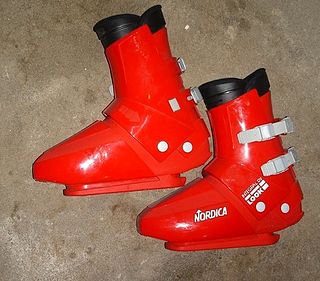
The Look Integral was a downhill ski binding that worked in conjunction with a custom ski boot made by Nordica. The Integral was fairly common in ski rental shops in the 1980s and into the 90s, but has since disappeared.
Hanson Industries invented and popularized the rear-entry ski boot. Formed by brothers Chris and Denny Hanson in 1969, the company became a huge success in the late 1970s. A series of mis-steps in the early 1980s led to a rapid death spiral and the company went bankrupt in 1984. It was purchased by Daiwa, a Japanese fishing tackle company that handled Hanson's distribution in Japan. Daiwa ended sales in North America and Europe. European products, notably the famous Salomon SX series, used Hanson's exit as a springboard to market domination during the second half of the 1980s. Denny Hanson later introduced the "Apex" design, which combines features of alpine and snowboarding boots.
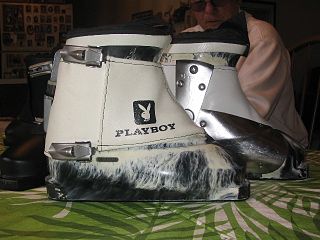
Rosemount Ski Boots introduced one of the earliest all-plastic ski boots for the downhill skiing market, competing with Bob Lange for the title of "first". Rosemount's design was easily distinguished by its use of the uncommon "side-entry" method for putting the boot on, which was rare at the time and is no longer used.
Lange is a major producer of ski boots used in alpine (downhill) skiing. They introduced the world's first plastic ski boots in 1962, and a greatly improved model aimed at the racing market in 1965. After several World Cup and Olympics wins in 1967 and 1968 made them a must-have on the circuit, Lange has remained a force in the racing market ever since. Their boots have equipped five times as many World Cup medal winners as any other brand into the 2000s.

The Flexon was a downhill ski boot introduced by Raichle in the winter of 1980/81. Based on designs by Sven Coomer, Al Gross and Erik Giese, the Flexon used a unique system to control forward flex in a predictable way, as well as making the boot more comfortable and easier to put on and remove. The basic layout was, and is, generally referred to as a "three-piece" design -- three-piece boots preceding the Flexon included the Henke Strato, Nordica Comp 3 and a dozen other designs from Italian bootmakers.



